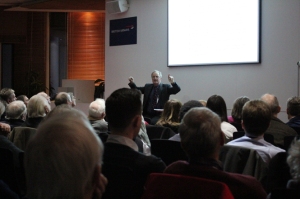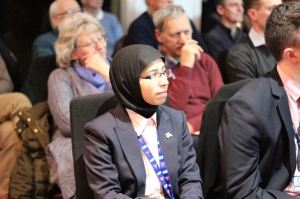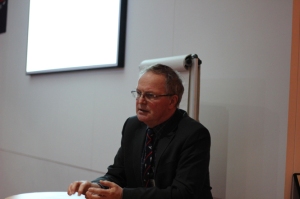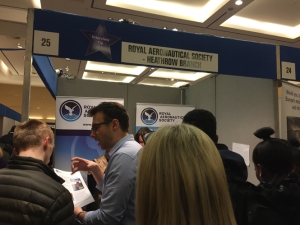On the 9th February 2017, the Royal Aeronautical Society Heathrow Branch successfully participated in a full day community and careers outreach event at the 10th Heathrow Jobs & Careers Fair, as well as concluded the February 2017 monthly lecture at the Red Triangle Theatre, British Airways Waterside HQ, with an highly controversial topic – “Airspace Sovereignty: The Loss of MH17- An Avoidable Tragedy?”. The lecture was presented by Professor Keith Hayward, former Head of Research at the Royal Aeronautical Society.
Professor Hayward began by introducing the key themes of his presentation, the ideas behind what constitutes airspace sovereignty and the vulnerability of commercial airliners to missile attack. His opening facts were striking, particularly when he covered those behind commercial airliners being shot down, whether malicious or accidental. Most recent attention has focused on the dangers of Manpads, or portable missiles, yet the most serious incidents have been from longer range missile systems, controlled by recognised armed forces. Despite this only 1400 people having been killed as a result of such events and it was evident that the risk is much lower than people expect. As Professor Hayward described, flying is still much safer than crossing the road at the airport!
 Throughout the evening, Professor Hayward welcomed the audience participation and described his lecture as an interactive one. The audience certainly enjoyed participating in the discussions and the Professor was able to lead conversations on complex ideas following the event. He went on to look at three case studies, all aircraft which were shot down for a number of different reasons, in a variety of scenarios with regards to location and pilot response. They included the Iranian Airbus shot down by a US warship and the Korean Airlines B747 which was destroyed by a Soviet fighter. Despite the circumstances for each event being very different, there were common themes between the three.
Throughout the evening, Professor Hayward welcomed the audience participation and described his lecture as an interactive one. The audience certainly enjoyed participating in the discussions and the Professor was able to lead conversations on complex ideas following the event. He went on to look at three case studies, all aircraft which were shot down for a number of different reasons, in a variety of scenarios with regards to location and pilot response. They included the Iranian Airbus shot down by a US warship and the Korean Airlines B747 which was destroyed by a Soviet fighter. Despite the circumstances for each event being very different, there were common themes between the three.
The speaker then discussed on one particular event, the loss of MH17. This is still a very controversial topic with regarding blame for the attack. Using information from the Dutch investigation, Professor Hayward was able to give an objective view on the background of the event, focusing on the reasons why the event happened, as opposed to what happened. One part that stood out was the focus on the weaponry that had been used to shoot down the aircraft, which was specialist and required a higher level of training by professionals in order to be used.
 He highlighted on the airspace issues associated with overflying that particular area of Ukraine. A key consideration was balancing the safety issues facing airlines. This involved avoiding using the popular route to SE Asia at the time, compared with the economic benefits of using the route, saving time and therefore fuel. It was argued that some of the major airlines had chosen to avoid that area, and the speaker progressed into discussing the possibilities of access of defence information both to and from the airlines.
He highlighted on the airspace issues associated with overflying that particular area of Ukraine. A key consideration was balancing the safety issues facing airlines. This involved avoiding using the popular route to SE Asia at the time, compared with the economic benefits of using the route, saving time and therefore fuel. It was argued that some of the major airlines had chosen to avoid that area, and the speaker progressed into discussing the possibilities of access of defence information both to and from the airlines.
A part of the lecture was aimed the possibility of a professional body producing a list of no-fly zones over hazardous areas. This was an ‘ideal’, and he went on to discuss the difficulties with regards to who would be able to have the power to do this. These included the bias of the members with regards to their political views affecting the decisions, particularly if they were involved in the conflict themselves.
 In a similar way, he described the issues with Ukraine closing part of the airways system or advising a different flight path to the south of the area. This would have made the Ukraine government look weak in comparison to the Separatists. They would have gained strength in the conflict knowing that Ukraine considered themselves unable to fully control their own airspace. Professor Hayward concluded his presentation on some of the possible ways to prevent such an accident happening again. The lecture was concluded with a usual Q&A section, which was very popular and created some thought provoking and diverse discussions.
In a similar way, he described the issues with Ukraine closing part of the airways system or advising a different flight path to the south of the area. This would have made the Ukraine government look weak in comparison to the Separatists. They would have gained strength in the conflict knowing that Ukraine considered themselves unable to fully control their own airspace. Professor Hayward concluded his presentation on some of the possible ways to prevent such an accident happening again. The lecture was concluded with a usual Q&A section, which was very popular and created some thought provoking and diverse discussions.
 On the very same day, the RAeS Heathrow Branch together with the staff members from the Society HQ’s Careers & Outreach Team has successfully participated at the 10TH Annual Heathrow Jobs & Careers Fair at Sofitel Heathrow Terminal 5 Arora Suite. During the full day event, run between 09:30 to 19:00, our stand was visited by over a thousand young students who between 16 and 24 age and offered them with the FREE Society membership, careers information, as well as encouraged them to participating in the Branch events in the British Airways Waterside HQ. Post Careers Fair and lecture, Young Members from the Heathrow Branch once again got-together at the local Pub for a young member’s informal social and networking drink/dinner, which was well received among young attendees.
On the very same day, the RAeS Heathrow Branch together with the staff members from the Society HQ’s Careers & Outreach Team has successfully participated at the 10TH Annual Heathrow Jobs & Careers Fair at Sofitel Heathrow Terminal 5 Arora Suite. During the full day event, run between 09:30 to 19:00, our stand was visited by over a thousand young students who between 16 and 24 age and offered them with the FREE Society membership, careers information, as well as encouraged them to participating in the Branch events in the British Airways Waterside HQ. Post Careers Fair and lecture, Young Members from the Heathrow Branch once again got-together at the local Pub for a young member’s informal social and networking drink/dinner, which was well received among young attendees.
Looking forward to the March 2017 lecture, chosen as the Sir Richard Fairey Named Lecture, the RAeS Heathrow Branch is welcoming Pierre Carpentier and Olivier Frerotte from Thales Avionics to present a lecture entitles ‘Advances in Airport Technology’. They will introduce the issues surrounding taxiing aircraft at large airports with regards to efficiency and safety and discuss the benefits of airport operations. You can now register online to attend our lectures at tiny.cc/RAeSLHR.
Eleanor McBrien, 11 February 2017

